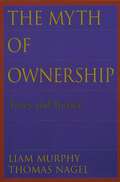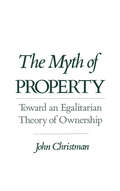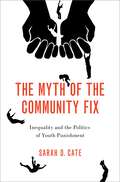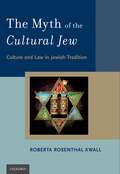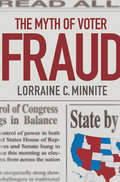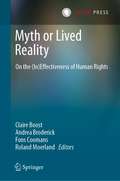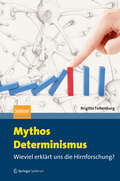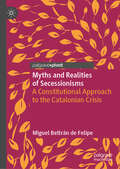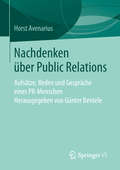- Table View
- List View
The Myth of Measurement: Inspection, audit, targets and the public sector (SAGE Swifts)
by Nick FrostIn the public sector inspection regimes and performance targets provide a powerful and dominant narrative, often placing pressure on professionals and organisations to continuously quantify the quality of services and to achieve targets. This book explores the background, development, techniques and impact of such regimes across areas of the public sector including schools, universities, police forces, children’s services and health services. Putting inspection and audit regimes under scrutiny, the author questions their role and function across these organisations and builds a persuasive critical argument for the re-thinking of public accountability mechanisms and techniques.
The Myth of Measurement: Inspection, audit, targets and the public sector (SAGE Swifts)
by Nick FrostIn the public sector inspection regimes and performance targets provide a powerful and dominant narrative, often placing pressure on professionals and organisations to continuously quantify the quality of services and to achieve targets. This book explores the background, development, techniques and impact of such regimes across areas of the public sector including schools, universities, police forces, children’s services and health services. Putting inspection and audit regimes under scrutiny, the author questions their role and function across these organisations and builds a persuasive critical argument for the re-thinking of public accountability mechanisms and techniques.
The Myth of Ownership: Taxes and Justice
by Liam Murphy Thomas NagelIn a capitalist economy, taxes are the most important instrument by which the political system puts into practice a conception of economic and distributive justice. Taxes arouse strong passions, fueled not only by conflicts of economic self-interest, but by conflicting ideas of fairness. Taking as a guiding principle the conventional nature of private property, Murphy and Nagel show how taxes can only be evaluated as part of the overall system of property rights that they help to create. Justice or injustice in taxation, they argue, can only mean justice or injustice in the system of property rights and entitlements that result from a particular regime. Taking up ethical issues about individual liberty, interpersonal obligation, and both collective and personal responsibility, Murphy and Nagel force us to reconsider how our tax policy shapes our system of property rights.
The Myth of Ownership: Taxes and Justice
by Thomas Nagel Liam MurphyIn a capitalist economy, taxes are the most important instrument by which the political system puts into practice a conception of economic and distributive justice. Taxes arouse strong passions, fueled not only by conflicts of economic self-interest, but by conflicting ideas of fairness. Taking as a guiding principle the conventional nature of private property, Murphy and Nagel show how taxes can only be evaluated as part of the overall system of property rights that they help to create. Justice or injustice in taxation, they argue, can only mean justice or injustice in the system of property rights and entitlements that result from a particular regime. Taking up ethical issues about individual liberty, interpersonal obligation, and both collective and personal responsibility, Murphy and Nagel force us to reconsider how our tax policy shapes our system of property rights.
The Myth of Rights: The Purposes and Limits of Constitutional Rights
by Ashutosh BhagwatWhat is a constitutional right? If asked, most Americans would say that it is an entitlement to act as one pleases - i.e., that rights protect autonomy. That understanding, however, is wrong; it is, indeed, The Myth of Rights. The primary purpose and effect of constitutional rights in our society is structural. These rights restrain governmental power in order to maintain a balance between citizens and the State, and an appropriately limited role for the State in our society. Of course, restricting governmental power does have the effect of advancing individual autonomy, but that is not the primary purpose of rights, and furthermore, constitutional rights protect individual autonomy to a far lesser degree that is generally believed. Professor Bhagwat brings clarity to many difficult controversies with a structural approach towards constitutional rights. Issues discussed include flag-burning, the ongoing debates over affirmative action and same-sex marriage, and the great battles over executive power fought during the second Bush Administration. The Myth of Rights addresses the constitutional issues posed in these and many other areas of law and public policy, and explains why a structural approach to constitutional rights illuminates these disputes in ways that an autonomy-based approach cannot. Readers will understand that while constitutional rights play a critical role in our legal and political system, it is a very different role from what is commonly assumed.
The Myth of the Community Fix: Inequality and the Politics of Youth Punishment
by Sarah D. CateA detailed examination of the limitations and pitfalls of pursuing the community-based reform movement in the American criminal justice system. As the extent of America's mass incarceration crisis has come into sharper view, politicians, activists and non-profit foundations from across the political spectrum have united around "community-based" reforms. Many states are pursuing criminal justice reforms that aim to move youth out of state-run prisons and into community-based alternatives as a way of improving the lives of youth caught in the juvenile justice system. In The Myth of the Community Fix, Sarah D. Cate demonstrates that rather than a panacea, community-based juvenile justice reforms have resulted in a dangerous constellation of privatized institutions with little oversight. Focusing on case studies of three leading states for this model of reform--Texas, California, and Pennsylvania--Cate provides a comprehensive look at the alarming on-the-ground consequences of the turn towards community in an era of austerity. Although often portrayed as a break with past practices, this book documents how community-based reforms are the latest in a long line of policy prescriptions that further individualize the problem of delinquency, bolster punitiveness, and reduce democratic accountability. Through contextualizing the community-based reform movement as part of the broader shift away from the centralized provision of public goods in the United States, Cate shows why those committed to addressing the problems of mass incarceration should be wary of the community fix.
The Myth of the Community Fix: Inequality and the Politics of Youth Punishment
by Sarah D. CateA detailed examination of the limitations and pitfalls of pursuing the community-based reform movement in the American criminal justice system. As the extent of America's mass incarceration crisis has come into sharper view, politicians, activists and non-profit foundations from across the political spectrum have united around "community-based" reforms. Many states are pursuing criminal justice reforms that aim to move youth out of state-run prisons and into community-based alternatives as a way of improving the lives of youth caught in the juvenile justice system. In The Myth of the Community Fix, Sarah D. Cate demonstrates that rather than a panacea, community-based juvenile justice reforms have resulted in a dangerous constellation of privatized institutions with little oversight. Focusing on case studies of three leading states for this model of reform--Texas, California, and Pennsylvania--Cate provides a comprehensive look at the alarming on-the-ground consequences of the turn towards community in an era of austerity. Although often portrayed as a break with past practices, this book documents how community-based reforms are the latest in a long line of policy prescriptions that further individualize the problem of delinquency, bolster punitiveness, and reduce democratic accountability. Through contextualizing the community-based reform movement as part of the broader shift away from the centralized provision of public goods in the United States, Cate shows why those committed to addressing the problems of mass incarceration should be wary of the community fix.
The Myth of the Cultural Jew: Culture and Law in Jewish Tradition
by Roberta Rosenthal KwallA myth exists that Jews can embrace the cultural components of Judaism without appreciating the legal aspects of the Jewish tradition. This myth suggests that law and culture are independent of one another. In reality, however, much of Jewish culture has a basis in Jewish law. Similarly, Jewish law produces Jewish culture. A cultural analysis paradigm provides a useful way of understanding the Jewish tradition as the product of both legal precepts and cultural elements. This paradigm sees law and culture as inextricably intertwined and historically specific. This perspective also emphasizes the human element of law's composition and the role of existing power dynamics in shaping Jewish law. In light of this inevitable intersection between culture and law, The Myth of the Cultural Jew: Culture and Law in Jewish Tradition argues that Jewish culture is shallow unless it is grounded in Jewish law. Roberta Rosenthal Kwall develops and applies a cultural analysis paradigm to the Jewish tradition that departs from the understanding of Jewish law solely as the embodiment of Divine command. Her paradigm explains why both law and culture must matter to those interested in forging meaningful Jewish identity and transmitting the tradition.
The Myth of the Cultural Jew: Culture and Law in Jewish Tradition
by Roberta Rosenthal KwallA myth exists that Jews can embrace the cultural components of Judaism without appreciating the legal aspects of the Jewish tradition. This myth suggests that law and culture are independent of one another. In reality, however, much of Jewish culture has a basis in Jewish law. Similarly, Jewish law produces Jewish culture. A cultural analysis paradigm provides a useful way of understanding the Jewish tradition as the product of both legal precepts and cultural elements. This paradigm sees law and culture as inextricably intertwined and historically specific. This perspective also emphasizes the human element of law's composition and the role of existing power dynamics in shaping Jewish law. In light of this inevitable intersection between culture and law, The Myth of the Cultural Jew: Culture and Law in Jewish Tradition argues that Jewish culture is shallow unless it is grounded in Jewish law. Roberta Rosenthal Kwall develops and applies a cultural analysis paradigm to the Jewish tradition that departs from the understanding of Jewish law solely as the embodiment of Divine command. Her paradigm explains why both law and culture must matter to those interested in forging meaningful Jewish identity and transmitting the tradition.
The Myth of the Litigious Society: Why We Don't Sue (Chicago Series in Law and Society)
by David M. EngelWhy do Americans seem to sue at the slightest provocation? The answer may surprise you: we don’t! For every “Whiplash Charlie” who sees a car accident as a chance to make millions, for every McDonald’s customer to pursue a claim over a too-hot cup of coffee, many more Americans suffer injuries but make no claims against those responsible or their insurance companies. The question is not why Americans sue but why we don’t sue more often, and the answer can be found in how we think about injury and personal responsibility. With this book, David M. Engel demolishes the myth that America is a litigious society. The sobering reality is that the vast majority of injury victims—more than nine out of ten—rely on their own resources, family and friends, and government programs to cover their losses. When real people experience serious injuries, they don’t respond as rational actors. Trauma and pain disrupt their thoughts, and potential claims are discouraged by negative stereotypes that pervade American television and popular culture. (Think Saul Goodman in Breaking Bad, who keeps a box of neck braces in his office to help clients exaggerate their injuries.) Cultural norms make preventable injuries appear inevitable—or the victim’s fault. We’re taught to accept setbacks stoically and not blame someone else. But this tendency to “lump it” doesn’t just hurt the victims; it hurts us all. As politicians continue to push reforms that miss the real problem, we risk losing these claims as a way to quickly identify unsafe products and practices. Because injuries disproportionately fall on people with fewer resources, the existing framework creates a social underclass whose needs must be met by government programs all citizens shoulder while shielding those who cause the harm. It’s time for America to have a more responsible, blame-free discussion about injuries and the law. With The Myth of the Litigious Society, Engel takes readers clearly and powerfully through what we really know about injury victims and concludes with recommendations for how we might improve the situation.
The Myth of the Litigious Society: Why We Don't Sue (Chicago Series in Law and Society)
by David M. EngelWhy do Americans seem to sue at the slightest provocation? The answer may surprise you: we don’t! For every “Whiplash Charlie” who sees a car accident as a chance to make millions, for every McDonald’s customer to pursue a claim over a too-hot cup of coffee, many more Americans suffer injuries but make no claims against those responsible or their insurance companies. The question is not why Americans sue but why we don’t sue more often, and the answer can be found in how we think about injury and personal responsibility. With this book, David M. Engel demolishes the myth that America is a litigious society. The sobering reality is that the vast majority of injury victims—more than nine out of ten—rely on their own resources, family and friends, and government programs to cover their losses. When real people experience serious injuries, they don’t respond as rational actors. Trauma and pain disrupt their thoughts, and potential claims are discouraged by negative stereotypes that pervade American television and popular culture. (Think Saul Goodman in Breaking Bad, who keeps a box of neck braces in his office to help clients exaggerate their injuries.) Cultural norms make preventable injuries appear inevitable—or the victim’s fault. We’re taught to accept setbacks stoically and not blame someone else. But this tendency to “lump it” doesn’t just hurt the victims; it hurts us all. As politicians continue to push reforms that miss the real problem, we risk losing these claims as a way to quickly identify unsafe products and practices. Because injuries disproportionately fall on people with fewer resources, the existing framework creates a social underclass whose needs must be met by government programs all citizens shoulder while shielding those who cause the harm. It’s time for America to have a more responsible, blame-free discussion about injuries and the law. With The Myth of the Litigious Society, Engel takes readers clearly and powerfully through what we really know about injury victims and concludes with recommendations for how we might improve the situation.
The Myth of the Litigious Society: Why We Don't Sue (Chicago Series in Law and Society)
by David M. EngelWhy do Americans seem to sue at the slightest provocation? The answer may surprise you: we don’t! For every “Whiplash Charlie” who sees a car accident as a chance to make millions, for every McDonald’s customer to pursue a claim over a too-hot cup of coffee, many more Americans suffer injuries but make no claims against those responsible or their insurance companies. The question is not why Americans sue but why we don’t sue more often, and the answer can be found in how we think about injury and personal responsibility. With this book, David M. Engel demolishes the myth that America is a litigious society. The sobering reality is that the vast majority of injury victims—more than nine out of ten—rely on their own resources, family and friends, and government programs to cover their losses. When real people experience serious injuries, they don’t respond as rational actors. Trauma and pain disrupt their thoughts, and potential claims are discouraged by negative stereotypes that pervade American television and popular culture. (Think Saul Goodman in Breaking Bad, who keeps a box of neck braces in his office to help clients exaggerate their injuries.) Cultural norms make preventable injuries appear inevitable—or the victim’s fault. We’re taught to accept setbacks stoically and not blame someone else. But this tendency to “lump it” doesn’t just hurt the victims; it hurts us all. As politicians continue to push reforms that miss the real problem, we risk losing these claims as a way to quickly identify unsafe products and practices. Because injuries disproportionately fall on people with fewer resources, the existing framework creates a social underclass whose needs must be met by government programs all citizens shoulder while shielding those who cause the harm. It’s time for America to have a more responsible, blame-free discussion about injuries and the law. With The Myth of the Litigious Society, Engel takes readers clearly and powerfully through what we really know about injury victims and concludes with recommendations for how we might improve the situation.
The Myth of the Litigious Society: Why We Don't Sue (Chicago Series in Law and Society)
by David M. EngelWhy do Americans seem to sue at the slightest provocation? The answer may surprise you: we don’t! For every “Whiplash Charlie” who sees a car accident as a chance to make millions, for every McDonald’s customer to pursue a claim over a too-hot cup of coffee, many more Americans suffer injuries but make no claims against those responsible or their insurance companies. The question is not why Americans sue but why we don’t sue more often, and the answer can be found in how we think about injury and personal responsibility. With this book, David M. Engel demolishes the myth that America is a litigious society. The sobering reality is that the vast majority of injury victims—more than nine out of ten—rely on their own resources, family and friends, and government programs to cover their losses. When real people experience serious injuries, they don’t respond as rational actors. Trauma and pain disrupt their thoughts, and potential claims are discouraged by negative stereotypes that pervade American television and popular culture. (Think Saul Goodman in Breaking Bad, who keeps a box of neck braces in his office to help clients exaggerate their injuries.) Cultural norms make preventable injuries appear inevitable—or the victim’s fault. We’re taught to accept setbacks stoically and not blame someone else. But this tendency to “lump it” doesn’t just hurt the victims; it hurts us all. As politicians continue to push reforms that miss the real problem, we risk losing these claims as a way to quickly identify unsafe products and practices. Because injuries disproportionately fall on people with fewer resources, the existing framework creates a social underclass whose needs must be met by government programs all citizens shoulder while shielding those who cause the harm. It’s time for America to have a more responsible, blame-free discussion about injuries and the law. With The Myth of the Litigious Society, Engel takes readers clearly and powerfully through what we really know about injury victims and concludes with recommendations for how we might improve the situation.
The Myth of the Out of Character Crime
by Stanton E. SamenowFrom time to time, into the news burst accounts of regular people who commit crimes that seem totally out of character according to those who know them well. Lee Malvo, one of the D.C. snipers, was known to his friends and family as a smart, promising man. Steven, was a talented, young scientist with no criminal record. No one suspected he was capable of injuring another-until he was arrested for abducting a man, handcuffing him, and threatening to blow off his head with a pistol. What makes these otherwise stable and respected men and women commit crimes? Why do those who know them best not see the signs? Are there clues people can look out for when a person is about to snap? What in the psychological makeup of defendants resulted in their committing crimes? Here, a seasoned forensic psychologist delves into the psyches of these otherwise normal people, whom he has treated and researched for many years.With first-hand experience interviewing and treating such offenders, Samenow is able to offer numerous case examples of everyday people committing extraordinary crimes. He reveals the significant clues that help to unmask these criminals and the seemingly mundane aspects of their daily lives. The way a person handles money, consumption of alcohol, sexual history, marital conflicts, job history and performance, interests and hobbies, reading preferences, ambitions and goals, and reactions to frustrations all contribute to the factors leading up to the criminal act. By probing into these and other aspects of the offenders' lives, the author finds a context for the crimes they commit. He concludes that the out of character crime does not exist, that the crime is merely the outer manifestation of what lies beneath the surface. By taking readers through the steps necessary to understand these criminals, the author shows how we can all read the signs before it is too late. He uses real life examples in every chapter to illustrate his points and readers will come away with a better understanding of how these criminals operate.
The Myth of Voter Fraud
by Lorraine C. MinniteAllegations that widespread voter fraud is threatening to the integrity of American elections and American democracy itself have intensified since the disputed 2000 presidential election. The claim that elections are being stolen by illegal immigrants and unscrupulous voter registration activists and vote buyers has been used to persuade the public that voter malfeasance is of greater concern than structural inequities in the ways votes are gathered and tallied, justifying ever tighter restrictions on access to the polls. Yet, that claim is a myth. In The Myth of Voter Fraud, Lorraine C. Minnite presents the results of her meticulous search for evidence of voter fraud. She concludes that while voting irregularities produced by the fragmented and complex nature of the electoral process in the United States are common, incidents of deliberate voter fraud are actually quite rare. Based on painstaking research aggregating and sifting through data from a variety of sources, including public records requests to all fifty state governments and the U.S. Justice Department, Minnite contends that voter fraud is in reality a politically constructed myth intended to further complicate the voting process and reduce voter turnout. She refutes several high-profile charges of alleged voter fraud, such as the assertion that eight of the 9/11 hijackers were registered to vote, and makes the question of voter fraud more precise by distinguishing fraud from the manifold ways in which electoral democracy can be distorted. Effectively disentangling misunderstandings and deliberate distortions from reality, The Myth of Voter Fraud provides rigorous empirical evidence for those fighting to make the electoral process more efficient, more equitable, and more democratic.
Myth or Lived Reality: On the (In)Effectiveness of Human Rights
by Claire Boost Andrea Broderick Fons Coomans Roland MoerlandChapters How Human Rights Cross-Pollinate and Take Root: Local Governments & Refugees in Turkey by Elif Durmuş and Human Rights Localisation and Individual Agency: From ‘Hobby of the Few’ to the Few Behind the Hobby by Tihomir Sabchev, Sara Miellet, and Elif Durmuş are available open access under a Creative Commons Attribution 4.0 International License via link.springer.comThis book seeks to explore, from a multidisciplinary perspective, whether human rights are, in fact, a myth or a lived reality. Over the years much has been said about their effectiveness or, rather, their ineffectiveness.This perceived ineffectiveness relates not only to institutional challenges at the international level, but also to national implementation mechanisms and processes. In addition, questions have arisen as to whether individuals or groups of individuals actually benefit from the normative guarantees contained in human rights law and whether human rights as legal constructs can be effectively translated into better outcomes.This volume can be distinguished from the existing literature by virtue of the fact that it not only brings together scholars at different stages of their careers, but also that it incorporates contributions that adopt different methodological perspectives and cover a variety of topics.The book should prove of great benefit to human rights researchers, human rights practitioners, NGOs and students.Claire Boost is a PhD Candidate at the Department of Criminal Law and Criminology, Maastricht University.Andrea Broderick is an Assistant Professor at the Department of International and European Law, Maastricht University.Fons Coomans is a Professor at the UNESCO Chair in Human Rights and Peace, Department of International and European Law, Maastricht University.Roland Moerland is an Assistant Professor at the Department of Criminal Law and Criminology, Maastricht University.
Mythologies of Transhumanism
by Michael HauskellerThis book examines the dependence of transhumanist arguments on the credibility of the narratives of meaning in which they are embedded. By taking the key ideas from transhumanist philosophy – the desirability of human self-design and immortality, the elimination of all suffering and the expansion of human autonomy – Michael Hauskeller explores these narratives and the understanding of human nature that informs them. Particular attention is paid to the theory of transhumanism as a form of utopia, stories of human nature, the increasing integration of the radical human enhancement project into the cultural mainstream, and the drive to upgrade from flesh to machine.
Mythos Determinismus: Wieviel erklärt uns die Hirnforschung?
by Brigitte FalkenburgAus Sicht von Neurobiologen regiert das neuronale Geschehen im Kopf unser Bewusstsein. Als Physikerin und Philosophin hinterfragt die Autorin in diesem Buch die Aussagen von Hirnforschern und stellt fest, dass die Neurobiologie an längst überholten mechanistischen Vorstellungen festhält und dadurch zu Fehlschlüssen über den menschlichen Geist und den freien Willen gelangt. Der Band liefert die Grundzüge einer Wissenschaftstheorie der Hirnforschung und weist damit den Weg zu einem differenzierteren Naturverständnis und Menschenbild.
Mythos Determinismus: Wieviel erklärt uns die Hirnforschung?
by Brigitte FalkenburgAus der Sicht der Neurobiologie regiert im Kopf das neuronale Geschehen. Doch was wissen die Hirnforscher genau über die Mechanismen des Hirngeschehens und ihren Einfluss auf den menschlichen Geist? Dieser Frage geht Brigitte Falkenburg nach. Die Physik hat sich längst vom mechanistischen Weltbild gelöst, in der Neurobiologie bleiben überholte mechanistische Vorstellungen bis heute wirksam. Dabei sind die "mechanistischen" Erklärungen der Hirnforschung ganz anders als ihr Name suggeriert; und wer annimmt, der Geist sei so strukturiert wie die Materie, zieht atomistische und kausale Fehlschlüsse über das Bewusstsein. Falkenburgs Buch möchte die Debatte um Geist und Gehirn, freien Willen und Determinismus endlich davon befreien. Es liefert Grundzüge einer Wissenschaftstheorie der Hirnforschung und eröffnet den Weg zu einem differenzierteren Naturverständnis und Menschenbild. Das beliebte Sachbuch ist für die zweite Auflage vollständig überarbeitet und aktualisiert worden.
Myths and Realities of Secessionisms: A Constitutional Approach to the Catalonian Crisis
by Miguel Beltrán de FelipeThis book provides a comprehensive overview of the Catalonian crisis in Spain from a historical, political and legal perspective. Using the precedents of Québec, Scotland, and partially Veneto and Bavaria, the author highlights some of the key issues of contemporary secessionist nationalism, including its relationship with sovereignty, the right to have a referendum, and the capacity of a particular territory to amend the constitution in order to admit secession.
The Myths We Live By: Adventures in Democracy, Free Speech and Other Liberal Inventions
by Peter CaveIn this witty and mischievous book, philosopher Peter Cave dissects the most controversial disputes today and uses philosophical argument to reveal that many issues are less straightforward than we'd like to believe. Leaving no sacred cow standing, Cave uses ingenious stories and examples to challenge our most strongly held assumptions. Is democracy inherently a good thing? What is the basis of so-called human rights? Is discrimination always bad? Are we morally obliged to accept refugees?In an age of identity politics and so-called 'fake news', this book is an essential resource for reinvigorating genuine public debate - and an entertaining challenge to accepted wisdom.
Nachbarrecht im Bauwesen: Schnelleinstieg für Architekten und Bauingenieure (essentials)
by Cornelius PfistererCornelius Pfisterer erklärt die Grundbegriffe zum Grundstücks- und Nachbarrecht und zeigt auf, was der Nachbar bei einem Bauvorhaben dulden muss und was er abwehren kann. In diesem essential erfahren Sie, wie das Hammerschlags- und Leiterrecht zugunsten des Bauherrn auch formal richtig geltend zu machen ist. Wichtige Unterschiede zwischen öffentlichem und privatem Recht werden erläutert. Praktische Hinweise zur Gestaltung einer Nachbarvereinbarung ergänzen die Darstellung der Rechtsgrundlagen. Wer sich hier nicht auskennt, riskiert gerade bei innerstädtischen Bauvorhaben aufgrund nachbarlicher Einwendungen erhebliche Bauverzögerungen, Planungsänderungen und Mehrkosten. Hier finden Sie die rechtlich-formalen Lösungen, wenn bspw. eine Unterfangung des Nachbargebäudes erforderlich wird, Wärmedämmmaßnahmen im Bestand geplant sind oder ein Baukran das Nachbargrundstück überschwenken muss.
Nachdenken über Public Relations
by Horst Avenarius Günter BenteleZentralen Themen der Beiträge des Bandes sind die Kernfragen des PR-Berufs. Sie reflektieren grundsätzliche und auch sehr konkrete Fragen von PR-Moral und PR-Ethik, beschäftigen sich mit Ethik-Institutionen wie dem deutschen PR-Rat DRPR, Fragen wie der Ausbildung für den PR-Beruf, der PR-Wissenschaft, Kulturarbeit, Kulturpolitik und Kulturkommunikation und die Kommunikation der Automobilindustrie. Die Texte von Horst Avenarius, darunter einige bislang unveröffentlichte Artikel, sind interessant für alle, die regelmäßig oder auch gelegentlich über diesen Beruf und das Berufsfeld nachdenken.
Nachhaltig leistungsfähig bleiben: Praxis-Tipps für den Business-Marathon
by Claudia KraazDurch das Buch „Nachhaltig leistungsfähig bleiben“ erfahren Sie, wie Sie im Businessalltag stressresistent, resilient und gesund bleiben. Denn das von Stress, Druck und Veränderungen geprägte Geschäftsleben ist kein Sprint, sondern ein Marathon. Daher ist es wichtig, den eigenen Energiespeicher bewusst zu managen. Kompakt und praxisorientiert erfahren Sie im ersten Teil des Buches, welches die Bestandteile nachhaltiger Leistungsfähigkeit sind. Dabei liegt der Schwerpunkt auf der Umsetzung von Handlungsempfehlungen. Dazu erhalten Sie zahlreiche Übungen und Praxis-Tipps. Im zweiten Teil werden diese Empfehlungen gespiegelt durch die Einschätzungen von prominenten Führungspersönlichkeiten. Aus den Interviews mit drei CEOs, drei Personalchefs und drei Experten über deren Erfahrungen mit dem Thema erhalten Sie wertvolle Impulse zur Umsetzung. Zielgruppen: Das Buch ist leicht lesbar und richtet sich an alle Berufstätigen und Führungskräfte. Zur Autorin: Claudia Kraaz ist Führungs- und Stress-Coach sowie Resilienz-Trainerin. Zuvor war sie über ein Jahrzehnt in leitenden Positionen in der Unternehmenskommunikation tätig.

